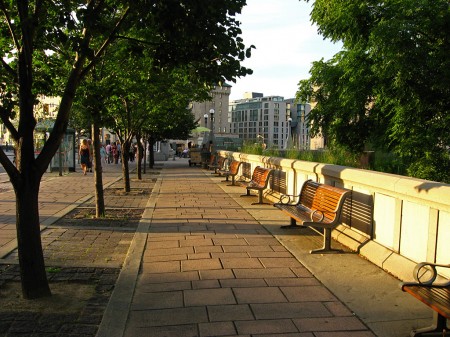A while ago, there was an excellent question posted as a comment. The Stern Review and other sources say that the world can absorb about five billion tonnes of carbon dioxide equivalent per year. If emissions are above that, atmospheric concentrations rise. If they are below that, they fall. Does that mean that, in the absence of human activity, concentrations would be falling, year-on-year? Are our first five gigatonnes of emissions stabilizing?
To answer this, you need to remember that there are two big kinds of carbon sinks out there. The first is embodied in forests, but consists of all biomass. A world where all the forests of North America and Europe were intact would have less carbon dioxide in the air because more would be in wood, leaves, etc. That being said, for any level of forest cover and atmospheric greenhouse gas, the biosphere will eventually reach an equilibrium point where it emits as much carbon dioxide (from decaying plants, etc) as it absorbs from the air. The biosphere is thus more like a cushion than like an eternal allowance.
The other kind of sink consists primarily of the deep sea. It’s like a great big sponge that absorbs carbon dioxide. At present, it can absorb about five billion tonnes of carbon dioxide equivalent per year (the source of the Stern number). Like a sponge, however, it can only carry on absorbing for some time. As the deep sea becomes saturated with carbon dioxide, a higher and higher proportion of what we emit will remain in the atmosphere causing climate change.
In the long run, then, we don’t have a perpetual allowance of five gigatonnes per year. We have some big sinks that can absorb about that much at present. We need to rapidly cut human emissions below this level. Then, over a longer period of time, we will need to phase them down to virtually nothing. Otherwise, we will always have to contend with rising atmospheric concentrations of greenhouse gasses and the environmental consequences thereof.


Can’t see the forest with the trees
IPCC needs to update projections to include deforestation feedbacks
Posted by Joseph Romm (Guest Contributor) at 6:23 PM on 20 Aug 2008
As deforestation accelerates and grows ever more concentrated the climate change consequences appear even greater than previously thought. As reported in New Scientist:
Pristine temperate forest stores three times more carbon than currently estimated by the Intergovernmental Panel on Climate Change, and 60% more than plantation forests, according to research in Australia.
You need to consider some geological factors, in the long term. Those are the only way that carbon gets durably removed from circulation.
True.
See this more recent post: The atmospheric longevity of carbon dioxide.
Cutting down on cutting down
How Brazil became the world leader in reducing environmental degradation
…
But how did it break the vicious cycle in which—it was widely expected—farmers and cattle ranchers (the main culprits in the Amazon) would make so much money from clearing the forest that they would go on cutting down trees until there were none left? After all, most other rainforest countries, such as Indonesia and the Democratic Republic of the Congo, have failed to stop the chainsaws. The answer, according to a paper just published in Science by Dan Nepstad of the Earth Innovation Institute in San Francisco, is that there was no silver bullet but instead a three-stage process in which bans, better governance in frontier areas and consumer pressure on companies worked, if fitfully and only after several false starts.
The first stage ran from the mid-1990s to 2004. This was when the government put its efforts into bans and restrictions. The Brazilian Forest Code said that, on every farm in the Amazon, 80% of the land had to be set aside as a forest reserve. As the study observes, this share was so high that the code could not be complied with—or enforced. This was the period of the worst deforestation. Soyabean prices were high and there was a vast expansion of soyabean farming and cattle ranching on the south-eastern fringe of the rainforest.
During the second stage, which ran from 2005 to 2009, the government tried to boost its ability to police the Amazon. Brazil’s president, Luis Inácio Lula da Silva, made stopping deforestation a priority, which resulted in better co-operation between different bits of the government, especially the police and public prosecutors. The area in which farming was banned was increased from a sixth to nearly half of the forest.
…
The third stage, which began in 2009, was a test of whether a regime of restrictions could survive as soyabean expansion resumed. The government shifted its focus from farms to counties (each state has scores of these). Farmers in the 36 counties with the worst deforestation rates were banned from getting cheap credit until those rates fell. The government also set up a proper land registry, requiring landowners to report their properties’ boundaries to environmental regulators. There was a cattle boycott modelled on the soya one. And for the first time, there were rewards as well as punishments: an amnesty for illegal clearances before 2008 and money from a special $1 billion Amazon Fund financed by foreign aid.